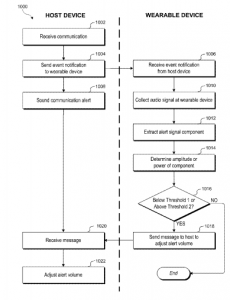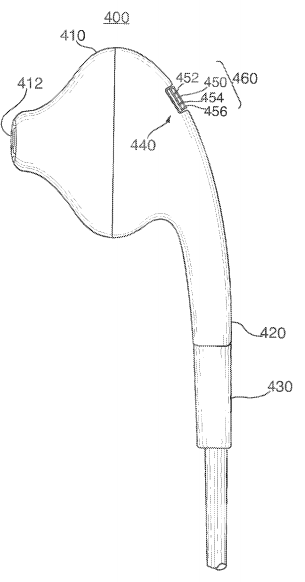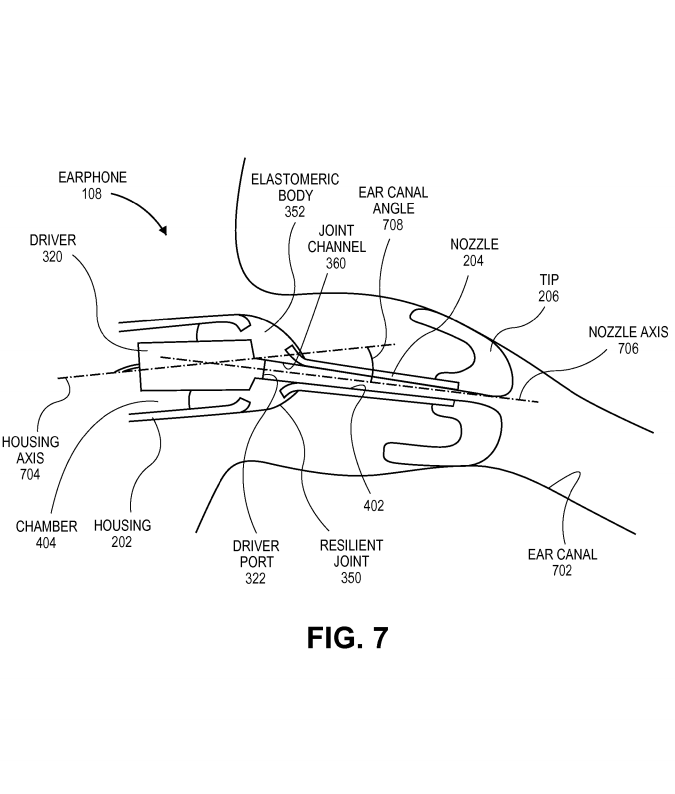aNewDomain — What will Apple’s upcoming wireless in-ear wearables, or hearables, look and sound like? How about its future hearing aids and consumer offerings to rock-abused Baby Boomer and Gen Xer ears?
This week, the USPTO published several Apple patent applications that hint at what’s to come. Taken together with other published patent applications, grants and trademarks, they begin to paint a clearer picture of what Apple in-ear devices for consumers and medical hearing aid products will offer. (Update Feb. 14, 2016: Scroll below the fold to read a trademark application reportedly filed by an Apple shell company for “Airpods.”)
Above, that’s a diagram found in an Apple patent application published on Dec. 31, 2015, which you might have missed. It describes an in-ear device that, because it fits right into the ear canal and not just in front of it, is designed to produce safer, higher-quality sound. Read the patent below the fold. You’ll see it fits right in with the wave of cutting-edge hearables beginning to hit the market right now.
But that’s far from the only hearable rumbles we hear coming from Cupertino. Check out the hearable and hearing aid-related Apple patent applications published by the USPTO this week. It’s a look at the sorts of features they portend.
Form-fitting design for better audio, lower power
As anyone who’s ever had to wear IFBs on radio or TV can tell you, in-ear devices are not one size fits all. Too big ones will constantly pop out, small ones feel abrasive. And ones that are too hard just plain hurt. Apple’s patent application, published this week, describes a tactic to improve the situation.
Apple patent Publication No. 20160044398 details a “Deformable ear tip for earphone and method therefor.” It’s an ear tip that you attach to a headphone, says the application, describing it as “suitable for in-ear operation … and (it) can have a cosmetic deformable outer member.” That’s an image from the patent application, above. The USPTO published it on Feb. 11, 2016.
The USPTO has not yet issued an office action regarding the patentability of the ‘398 publication.
Earbuds that essentially are Bluetooth/WiFi speakers, capable of playing digital music and music broadcasts wirelessly.
Published in October 2015, Apple filed for a patent on this invention, called “Untethered wireless audio system.” It describes how stereo sound can be wirelessly transmitted, using WiFi or Bluetooth, to speakers “such as left and right earbuds.” Read the application at this link or scroll below the fold to read it in place along with the other patent applications mentioned in this article.
Improved audio range for those who need it …
Published on Feb. 11, 2016, Apple has filed for a patent on an invention it calls “Converting audio to haptic feedback in an electronic device.” Read the full application here.
Some people with “hearing impairment(s) may be deaf to certain frequencies … potentially limiting the person’s ability to fully realize information contained in audio data,” the application begins. “For example, listening to music rich in high frequencies may be less enjoyable to a person who is partially or completely deaf to some or all of those high frequencies.” The system Apple proposes in its patent uses haptic technology  to convert such high-frequency sounds into lower frequencies that would be more audible.
to convert such high-frequency sounds into lower frequencies that would be more audible.
While Apple describes the hearing impaired in this patent, clearly one mustn’t be medically diagnosed as deaf or in need of a full-fledged hearing aid to qualify as someone who might benefit from fuller-frequency hearing, especially as it applies to listening to music. It isn’t hard to imagine an Apple hearable marketing message of “get your mojo back” to the millions of Baby Boomers in retirement right now, Boomers who blew both ranges of their hearing while having a little too much fun living their youthful rock ‘n’ roll lifestyles.
Automatically pumps up the volume when you’re in loud places
Using the device’s mic, an Apple in-ear hearable could wirelessly “tell” your computer or portable device how loud your environment is and then amp up the volume accordingly.
Apple’s newly published patent Publication No. 20160044151, is “Volume control for mobile device using a wireless device.”
The USPTO has already issued a non-final office action regarding the patentable merits of the ‘151 publication. All claims in the application currently stand rejected over a patent (US 8,285,344) owned by DP Technologies and a nearly expired patent (US 6,044,279) originally owned by NEC but now owned by Lenovo. Some of the dependent claims have been rejected over the above prior art references in combination with a patent (US 8,503,704) owned by Cochlear and an abandoned patent application (20050027522) filed by Toshiba.
The DP Technologies patent names as its inventors Borland Software Corp. founder Philippe Kahn as well Arthur Kinsolving, who works with Kahn at his wearables company Fullpower Technologies.
Apple has until April 22, 2016 to respond to the outstanding office action for the ‘151 publication but could wait as late as July 22, 2016 with the payment of a time extension fee. A copy of the office action is below the fold.
Noise cancellation with a twist
 Another patent application from Apple in the USPTO published file this week has to do with noise cancellation as it applies to hearing-aid and voice-amplification device users when using an Apple iPhone or other mobile device. The invention, basically, reduces interference and makes for clearer audio over all. The name of the patent Publication No. 20160044424 is “Audio device with a voice coil channel and a separately amplified telecoil channel.” It, too, was published this week.
Another patent application from Apple in the USPTO published file this week has to do with noise cancellation as it applies to hearing-aid and voice-amplification device users when using an Apple iPhone or other mobile device. The invention, basically, reduces interference and makes for clearer audio over all. The name of the patent Publication No. 20160044424 is “Audio device with a voice coil channel and a separately amplified telecoil channel.” It, too, was published this week.
The USPTO has not yet issued an office action regarding the patentability of the ‘424 publication.
Pressure-sensing earbuds for an airtight fit, better sound quality
Currently, Apple’s EarPods don’t offer an airtight fit. Presumably, Apple’s upcoming hearable products, reportedly called “AirPods,” could. The difference: better sound. Apple’s patent Publication No. 20150264472, published in September 2015, is fittingly called “Pressure-sensing earbuds and systems for the use thereof.” That’s an image from the published patent application, at right. The USPTO has not yet made a substantive review of the patentability of the ‘472 publication.
Concurrent data processing and voice handling to save battery power
Patent Publication No. 20160029345, published this January, describes an engineering method that will allow for hearables and other wireless wearable products to consume less battery power. It’s called “Concurrent data communication and voice call monitoring using dual SIM.” The USPTO has not yet issued an office action for the ‘345 publication.
Update:
Also in Apple’s collection of patent applications and granted patent are a number of inventions are a number of other inventions related to automatic noise cancellation.
Robust crosstalk cancellation using a speaker array (No. 20160021480, published Jan. 21, 2016)
It reads, in part:
“An embodiment of the invention is an audio receiver that performs crosstalk cancellation using a speaker array with a plurality of transducers. The audio receiver detects the location of a listener in a room or listening area and then processes a piece of sound program content to be output through the speaker array using one or more beam pattern matrices that correspond to the detected location of the listener. The beam pattern matrices each correspond to a particular audio frequency and are generated according to one or more constraints and may be preset in the audio receiver. The constraints may include (1) maximizing/increasing a left channel and minimizing/decreasing a right channel of a piece of sound program content at the left ear of the listener, (2) maximizing/increasing the right channel and minimizing/decreasing the left channel at the right ear of the listener, and (3) minimizing/decreasing sound in all other areas of the room.”
Off-ear detector for personal listening device with active noise control (20150310846, published October 2015)
Here’s an excerpt:
“The off-ear detector may operate continuously while an ANC process is running, during for example a phone call or while the user is listening to music. When the user suddenly removes an earphone from her ear or moves a phone handset away from her ear, without manually signaling the end of the call or pausing playback, the detector automatically asserts its control signal (or declares an off-ear event or state) which in turns causes a slow down or freezing/halting of the adaptation one or more adaptive filters used in the ANC process, or causes the deactivation or disabling of the ANC process.”
For aNewDomain, I’m Gina Smith.
Here’s the newly published Apple patent application regarding how mobile devices might automatically adjust volume to earpieces, hearables and other wearables, based on ambient noise.
Apple Patent Application: Wearable Volume Control
What will an Apple hearable look like? It might have some attributes found in this Apple patent Publication No. 20150382094. The application describes an in-ear device that “sits comfortably in the ear canal.” Read it in full below.
The USPTO has already issued a non-final office action regarding the patentability of the ‘094 application. The independent claims in the application have been rejected over a prior Apple patent (US 8,553,923) and a Sony Ericsson patent application (US 20120321103) which is still in prosecution. Some of the dependent claims have been rejected by these prior art references in combination with a Bose patent (US 8,249,287) and/or a patent (US 8,416,979) owned by Japanese design firm S’Next Co., Ltd.
The good news for Apple in the office action is that the patent examiner has found patentable novelty in several of the dependent claims. Thus, if Apple turns at least one of these dependent claims into an independent claim, then the ‘094 application could issue as a patent. The office action for the ‘094 publication, also known as application 14/318,436 is provided below.
Apple In Ear Patent Application (Dec. 31, 2015)
Calling All Patent Attorneys
Apple has adopted an interesting strategy for protecting its hearable intellectual property. Rather than relying on a single patent firm to handle the six product-related applications above, Apple has chosen to use four different IP firms. Venerable Silicon Valley patent boutique Blakely Sokoloff Taylor & Zafman LLP gets the ‘094 and ‘424 applications. New York newcomers Van Court & Aldridge LLP prosecute the ‘472 and ‘398 applications, while the journeyman Texas patent boutique Meyertons, Hood bird-dogs the ‘345 application. The international law firm Kilpatrick Townsend & Stockton LLP prosecutes the ‘151 application.
Our legal experts comment that this strategy is not unusual although it does require a certain amount of coordination, especially given the USPTO’s requirements regarding the sharing of prior art among related applications.
Here are a few other published Apple patent applications and copies of the two office actions issued thus far by the USPTO.
Here’s the full text of one of several Apple patent applications relating to noise-cancellation.
Apple Hearable Patent App – Robust Crosstalk Cancellation Using a Speaker Array
Here is the trademark application Apple reportedly filed under the name of a shell company. The trademark is for a product called “Airpods.” Apple Earpods is a strikingly similar name that, after all, refers to Apple’s current, wired earbuds.
Airpods US Trademark Application
Here is an Apple patent application that was published October 22, 2015, which describes how speakers (including, the example says, wireless earphones) handle audio in a wireless environment.













